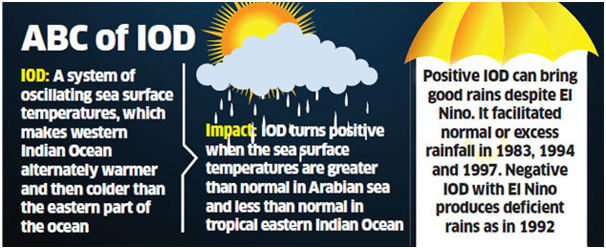

The dreaded El Nino is likely to be neutralised by a local phenomenon in the Indian Ocean, which can lead to good rainfall in the June-September season.
Context
The dreaded El Nino is likely to be neutralised by a local phenomenon in the Indian Ocean, which can lead to good rainfall in the June-September season.
About
El Nino:
- El Nino refers to the warming of the equatorial Pacific, which weakens the flow of wind and consequently the monsoon system. In some other parts of the world, it leads to heavy rainfall but in India it weakens rain.
- In this phenomenon, sea-surface temperatures rise over a threshold of +0.5 degree Celsius (and cools by the same margin during La Nina).
- There are a few other key atmospheric indices which one comes across while tracking El Nino. For instance, the Southern Oscillation Index (SOI) that gives an indication of the development and intensity of El Nino or La Nina. The SOI is calculated on the basis of the atmospheric pressure differences between Tahiti (South Pacific Ocean) and Darwin (Australia). Sustained positive SOI values are indicative of La Nina conditions while negative values suggest El Nino conditions.
- Another atmospheric indices is the ENSO (El Nino Southern Oscillation) which refers to the oscillation between the El Nino and the La Nina. ENSO shifts irregularly back and forth between El Nino and La Nina every two to seven years.
- Each phase led to disruptions of temperature, precipitation and winds.
- The warmer area of the ocean is also a source for convection and is associated with cloudiness and rainfall.
Indian Ocean Dipole (IOD)
- The phenomenon called Indian Ocean Dipole (IOD) refers to the temperature difference between the eastern and western parts of the water body.
- The negative impact of weak El Nino will be compensated by positive Indian Ocean Dipole. El Nino phenomenon is getting weak and IOD is moving from neutral to positive. This will help rains in the country. The monsoon would be near normal.

What lies ahead?
-
- El Nino has been generally known to suppress monsoon rainfall in India while La Nina increases it. El Nino years tend to be drier than average, but one of the strongest El Nino of the century (1997-98) produced a monsoon season with above-average rainfall for India.
- Anomalous warming in the Central and East Pacific could have a more profound adverse impact on the monsoon than when the warming shifts to the adjoining Far East Pacific.
- Last but not the least is the ‘dipole’ effect, wherein the Indian Ocean mimics El Nino-La Nina in which the western and eastern basins warm up relative to each other every few years with associated impact on the monsoon. Warming up of the West Indian Ocean boosts a prevailing monsoon, and vice-versa. International and domestic weather agencies expect that this year, the Indian Ocean dipole could be either ‘neutral’ or weakly positive.


